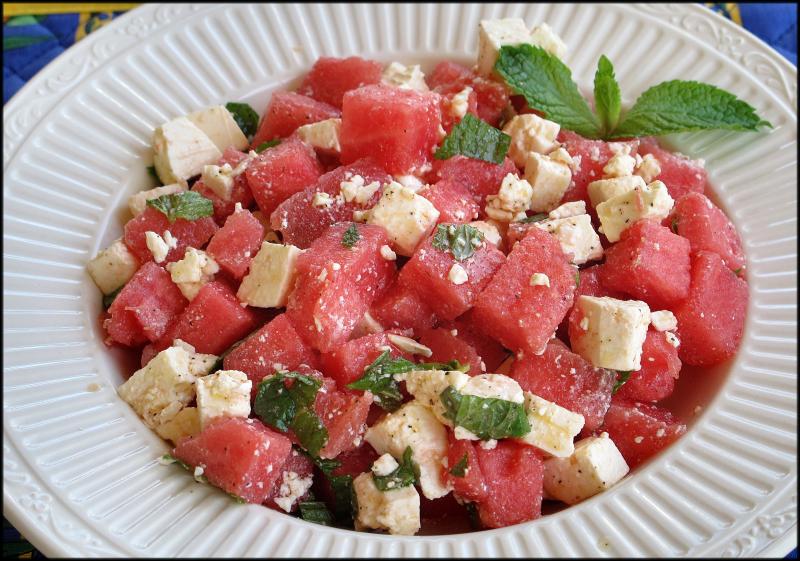Delaware prime growing area for watermelon
The familiar high temperatures of July and August have given the region's watermelon crop exactly what it needs - the right conditions to ripen. Delaware's sandy, well-drained soil is ideal for watermelon, sometimes called a "desert fruit" because of its origins in Southern Africa and affinity for heat.
Several growers had watermelons for sale at various local farmers markets, and they're stacked in pyramids at roadside stands and supermarkets. Although there are over 1,200 different cultivars of watermelon, they can be sorted into four basic types.
Most common of these are the picnic watermelons - large, oblong or round with a green rind and ruby-red flesh. A newer type is the seedless watermelon, which was hybridized in the 1990s. Smaller than the picnics, they're also green with red flesh and may have been misnamed: they have tiny, white undeveloped seeds.
Yellow/orange watermelons are grouped together. They also sport mottled green rind, but their flesh (both seeded and seedless) comes in colors ranging from pale yellow to deep golden. The final type of watermelon is called the icebox, because it is small enough to fit in a refrigerator (or its predecessor, the icebox).
In our house, it seems that no matter which type of watermelon we buy, we can't finish the entire melon before it dries out, despite choosing the smallest ones available. The folks at Bennett Orchards now offer a solution to this problem, growing a miniature personal-sized watermelon variety known as the Faerie watermelon.
This oblong hybrid has a creamy yellow rind with long stripes running from end to end. Its extremely sweet, crisp and juicy inner flesh is a bright pinkish-red. Before being cut, ripe Faeries will keep in the refrigerator for up to two weeks. Once you've cut into them (and if there are any leftovers), wrap them in plastic and eat within three days.
The Faerie watermelon is an ideal ingredient in both sweet and savory dishes. In salads, it pairs well with arugula, basil, mint, cilantro, lime, red onion, prosciutto and jalapeño. Pureed, the trimmed flesh is a lovely addition to sweet sauces, chilled soups and frozen desserts.
A few additional exotic melons from around the world are being offered by Bennett Orchards this season. Just one taste of Sugar Cube, a tiny cantaloupe with concentrated flavor, and you'll appreciate its name. Another Charentais melon (originating from a region of southern France) is French Orange, whose lovely flesh earns its name. Both of these will give you a new perspective on cantaloupe.
The Japanese ivory gaya cultivar known as the Snow Leopard has porcelain-colored rind splashed with green speckles and streaks. Inside, the flesh is quite crisp closest to the rind and full of creamy sweetness toward the center. Its flavor has echoes of honeydew with hints of pear and honey.
One of the odder-looking melons is the Spanish favorite Piel de Sapos (which means "toad skin" and explains why these are affectionately called "frogs"). This hardy melon is shaped like a football with a thick, slightly-ridged greenish outer skin (imagine a toad and you're close). Their bright white flesh is very sweet and juicy with a crunchy, crisp texture.
The final melon in this array is a canary melon, well-named for its bright yellow rind. Juicy, light-colored flesh makes this a good substitute in the watermelon-feta salad recipe seen in the photo. Not as photogenic as the pink watermelon flesh, but with a terrific flavor that contrasts beautifully with salty feta and bright mint.
I've included a few different ways to feature Faerie watermelons in the recipes below, but my favorite approach would be to cut off a slice to simply savor. In each of the dishes, you could substitute a canary melon, snow leopard or frog. But, if you've got one of the Charentais, don't plan on any leftovers, let alone sharing a single bite.
Watermelon Marinade
1/2 C watermelon juice
1/3 C Balsamic vinegar
1/4 C brown sugar
1/4 C soy sauce
2 T olive oil
1 1/2 T Dijon mustard
2 minced garlic cloves
1 t red pepper flakes
Whisk ingredients together until blended. Pour into a zip- top bag and add boneless chicken breasts or loin pork chops. Seal and refrigerate at least 4 hours or up to overnight. When ready to cook, grill or sauté, discarding remaining marinade. Yield: 1 1/2 C marinade.
Watermelon Juice
1 watermelon
Remove the rind and cut the watermelon into chunks, discarding seeds. Place chunks in a blender or the bowl of a food processor and puree until smooth. Pour puree through a strainer, discarding solids. Serve juice chilled or over ice, garnished with mint sprigs.
Watermelon Salad
1 Faerie watermelon
2 T olive oil
1 T white Balsamic vinegar
1 T lemon juice
1/4 C mint leaves
4 oz feta cheese
salt & pepper, to taste
Trim off watermelon rind (reserve for another use or discard) and cut flesh into half-inch cubes, removing large seeds. In a small bowl, whisk together oil, vinegar and lemon juice. Gently toss the watermelon cubes with vinaigrette in a serving bowl. Mince or tear mint leaves and sprinkle over salad. Add feta and stir to distribute. Season to taste with salt and pepper. Yield: 4 servings.
Watermelon Soup
1 Faerie watermelon
1 C orange juice
zest and juice of 1 lemon
1 T shredded basil
Remove the rind and cut the watermelon in large chunks, discarding seeds. Puree in a blender or food processor along with orange juice, lemon juice and zest. Stir in basil, reserving a few strands for garnish. Chill for at least one hour before serving. Yield: 2 servings.






















































